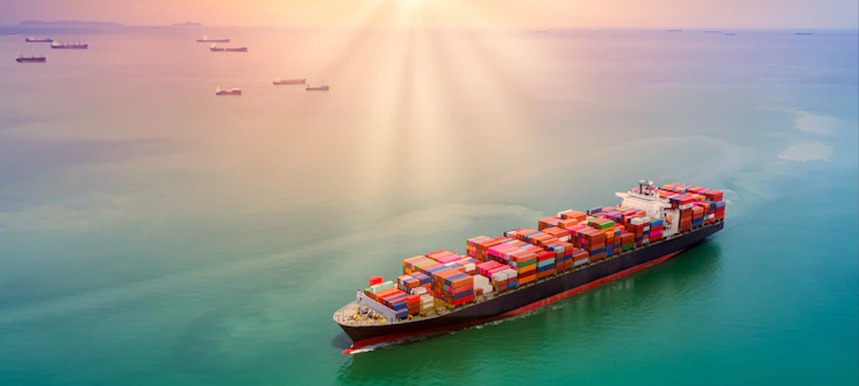What is Intermodal Shipping?
There are various modes of transportation in the supply chain, including trucks, ships, air, and rail. When a carrier combines two of these modes to move cargo from one location to another, with products stored in one container that does not require transfer to different containers, it is known as intermodal shipping.
Generally, intermodal shipping is a popular alternative to traditional options such as rail freight. It involves the use of a combination of transportation methods that improve efficiency and get shipments to their destinations more cheaply and quickly. As competition increases, supply chain managers are increasingly choosing intermodal shipping to move goods through a variety of means, such as OTR and rail.
Related article: What Is Expedited Shipping & Why Would I Need It

Benefits of intermodal shipping
Intermodal shipping has excellent benefits. It involves using a combination of transportation methods that improve efficiency and get shipments to their destinations cheaper and faster. Here are some of the main advantages of intermodal shipping
- Lower costs
The first and foremost benefit of intermodal shipping is costly. As supply chain teams can now pick and choose from a variety of transportation methods, they can optimize the total cost of delivery. For example, using rail lines is cheaper than using trucks, and then trucks can cover any remaining distance that rail lines cannot cover. This generally translates into less fuel usage and therefore savings.
- Increased access to capacity
Driver shortages and increased regulation around capacity mean that intermodal shipping allows supply chain teams to take advantage of higher capacity alternatives, such as cargo ships or rail, compared to using a single option, such as road transport.
- Environmental friendly
Another popular reason for supply chain teams to adopt intermodal shipping is to reduce the carbon footprint of their logistics process. Using options like the train can shorten distance and fuel usage, making it a more environmentally friendly option.
Related article: Four Logistics Trends to Watch
- Similar transit times
Taking rail as an example, moving via rail can result in similar end-to-end transit times compared to other alternatives. This is due to the boost in infrastructure development, technological improvements, and logistics efficiencies that have occurred in recent years in various geographies.
- Better security
Intermodal shipping also provides added security, as freight goods are rarely exchanged between different modes of transportation. The container simply moves from one shape to another. This ensures less chance of theft, loss, or damage. Most intermodal shipping processes also guarantee accurate tracking due to this lack of sharing between unknown third parties or intermediaries.
- Globalization
Intermodal shipping is the most reliable way to transport goods across borders. You can use various forms of infrastructure present in different countries and cities to move your products.
Related article: What Is Ground Freight Shipping & The Benefits Of It

How intermodal shipping works
The first step in understanding how intermodal shipping can benefit your business is understanding exactly how it works. Intermodal combines two other modes (truck and rail) to complete a single shipment. Use a truck for pickup, a train for the long haul, and another truck for delivery.
Your cargo stays in a single container and everything is recorded on a single bill of lading from start to finish. Here is an overview of the intermodal shipping process:
- Pick up
Your cargo is loaded into a detachable dry trailer or 53-foot intermodal shipping container, where it remains for the entire journey. It is then delivered to the rail yard.
- Long haul
At the rail yard, cargo is loaded onto a train. Once loaded, the shipment completes the long-haul portion of the route. Since there is no single rail system that can deliver to all destinations, it may sometimes be necessary to interconnect freight between different rail systems. Your cargo stays safe in your shipping container or trailer while you change rail lines.
- Delivery
Once the cargo completes the rail leg of the trip, another truck picks it up and delivers it to its final destination.
Related article: Make The Best Decisions For Your Shipments By Understanding Transport Options in Logistics

When to use this kind of shipping
Intermodal shipping has great benefits, but it’s not right for all situations. It’s the best choice if you’re shipping via long-distance routes, such as across multiple state lines or traveling across the country.
It is the perfect choice when moving multiple LTL shipments to the same destination on a consistent basis. Setting up intermodal routes can be a challenge, so many companies won’t do it unless you ship frequently via that method. Here are some tips to consider:
- Be careful with the packaging
Many carriers mistake “dumping” their goods into the shipping container, as these containers are often durable and strong. However, these containers experience a lot of movement during transportation, especially during loading and unloading. Therefore, you want to ensure that your products are properly packed within the container to protect them from damage. You want to use blocking, bracing, and packing to keep the load secure during movement.
- Take cost into account
Carriers calculate this kind of shipping similarly to a full truckload (FTL). It is calculated on a cost-per-mile or flat rate basis. You may also be responsible for secondary mode and storage fees at rail yards and docks, depending on who you work with.
- Each company will take a unique approach
Intermodal shipping naturally requires a lot of interaction and partnerships between different carriers. So you could get different routes, services, offers, and destinations depending on the company you work with.
Related article: 10 Most Commonly Asked Freight Shipping Questions In Logistics – Canada

Conclusion
This kind of shipping is a popular method that involves using a combination of transportation methods that improve efficiency and get shipments to their destinations more cheaply and quickly. It can save a company time and money, and improve overall supply chain and logistics operations. But it is not suitable for all situations.
Intermodal shipping is the perfect choice when moving multiple LTL shipments to the same destination on a consistent basis. Setting up intermodal routes can be a challenge, which is why many companies won’t do it unless you frequently ship via that method. It’s the best choice if you’re sending via long-distance routes, such as across multiple state lines or traveling across the country.





